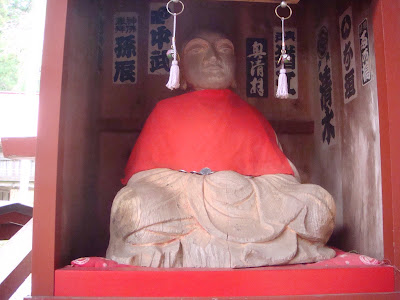The priest, I never got his name, spent about a half hour telling us about the history of the temple and the shrine. He seemed particularly interested in how they had started as a Shinto shrine and then added the Buddhist temple, remaining united for hundreds of years before reaching the current state of being a Buddhist temple but supporting the shrine. Of course, the story involved a lot of famous and rich people. I really wish that I had had a tape recorder so that I had a permanent record of his talk. His was a really pleasant person, just what I would expect from a Buddhist monk, and Ian and I very much enjoyed our time with him.

One of the things that he pointed out to us was the ceiling. Each panel had a different picture on it, all done by local artists. This type of ceiling is rare enough to be interesting, whether or not the art is good, but not so rare that people do not know about them.

In many temples the authorities do not like people to take pictures. In many temples the statues and other relics are locked way so that the common visitor can not see them. Occasionally some temple will have a special showing of something that has been hidden away for a few hundred years. I was lucky enough to see such a show in Kyoto one time. A group of about 15 statues had been sealed in containers for 500 years and were brought out for maintenance. After repairs and upkeep, they were resealed and put away to be opened again in 2500.
We were very lucky in this regard because the priest said that I could take any pictures that I wanted. So, while he was taking, I wandered around and took pictures as I listened to him. The next picture shows the altar area

This is the altar area as seen from the left side of the room. I am always amazed at how chaotic the altar is - many statues, bells, gongs, candles, various instruments for ceremonies, offerings of food, money, and other stuff, scripts of the various chants and ceremonies, and who knows what else.

One thing that I found very interesting was a picture that was resting on the floor in the left front corner of the room. It was a propaganda picture from WWII or maybe the war with Russia at the beginning of the 20th Century. I assume that it was originally related to the Shinto shrine, but the Buddhists also supported the war effort even though they had to distort Buddhism to do it, so it could be where it belonged. The priest saw me take the picture but he did not say anything, which to me indicated that he did not want to talk about it since he told us about everything else that we looked at. I decided to keep the rapport we had with him and so did not ask about it.

 Looking to our left, there were unplowed riced paddies in which two crows were scrounging their dinner.
Looking to our left, there were unplowed riced paddies in which two crows were scrounging their dinner. Looking to our right, we could see more rice paddies and in the distance a road (a numbered prefectural road) and the tracks that would eventually bring our train. As with almost any scenery in Japan, in the far distance we could see hills and then mountains.
Looking to our right, we could see more rice paddies and in the distance a road (a numbered prefectural road) and the tracks that would eventually bring our train. As with almost any scenery in Japan, in the far distance we could see hills and then mountains. While we were sitting there a very scruffy old cat came to visit. He really did not have much interest in us but checked us out and then went on his way.
While we were sitting there a very scruffy old cat came to visit. He really did not have much interest in us but checked us out and then went on his way.

















































